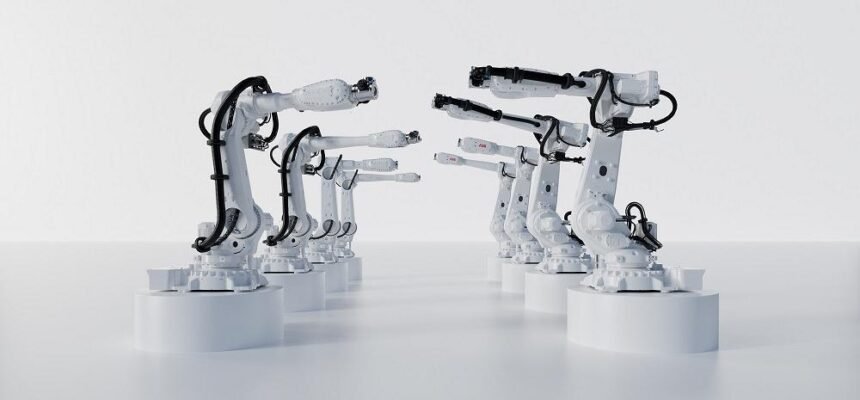Modern construction and industrial sites increasingly rely on robotics to manage layout tasks and material handling. By combining cutting-edge robotics, sensors, and data-driven planning, these systems help reduce errors, improve safety, cut costs, and boost efficiency. Here’s how they work and why they matter.
On‑site layout uses robotics such as robotic total stations or autonomous site-mapping units to mark out building features accurately and quickly.
Material handling employs robots like Automated Guided Vehicles, Autonomous Mobile Robots, robotic arms, or even autonomous forklifts to move tools, supplies, and materials where they’re needed.
These on-site systems combine navigation, software, and robotics to streamline tasks that would otherwise be labor-intensive or prone to errors.
Key Technologies
AGVs & AMRs
AGVs follow fixed paths (wires, lines, or magnetic tapes), while AMRs use onboard sensors and advanced navigation to move flexibly. Both types automate repetitive material movement.
Vision-Guided Robots
Cameras and sensors guide robotic arms, enabling them to pick, place, or palletize materials precisely, even from moving conveyors, boosting flexibility and accuracy.
Autonomous Forklifts
Recent developments include rugged autonomous forklifts built for dynamic construction environments. One study introduced the ADAPT system, capable of handling rough, off-road conditions and functioning comparably to human operators.
Robotic Total Stations
These devices automate the traditional layout process, using laser and GNSS positioning to mark critical layout points quickly and accurately.
Integration via BIM & Simulation
Using Building Information Modeling data, robots simulate layout paths and task sequences before execution. This improves navigation accuracy and minimizes on-site delays.
Benefits of Robotic Layout & Handling
Higher Precision
Robots use exact sensor input, GPS, and vision systems to reduce layout and placement errors. Robotic total stations, for example, ensure more accurate building alignments and foundations than manual methods.
Better Safety
Heavy lifting, repetitive tasks, or working around large equipment often cause injuries. Robots handle the most dangerous work, reducing risk and helping prevent musculoskeletal injuries.
Greater Speed & Productivity
Robots operate continuously without fatigue or breaks. In warehouse settings, automated systems like AutoStore nearly double throughput; on construction sites, robotic layout and handling speed up flow and reduce delays.
Cost Savings
Robotic implementation lowers labor costs and reduces rework due to fewer errors. Autonomous forklifts and AGVs especially help cut labor while operating safely in tough environments.
Adaptability & Flexibility
Vision-guided robots adapt to changing materials and layouts, while AMRs navigate around unpredictable site conditions, ideal for dynamic environments like construction sites.
Real-World Examples
Autonomous Forklift ADAPT: Developed for true off-road and unstructured conditions, ADAPT demonstrated automated load transport performance comparable to expert operators.
Robotic Total Stations: Widely used to replace manual layout with faster, error-free marking.
Vision-Guided Handling: Employed in industrial warehouses to handle parts from moving conveyors with high precision.
Design & Integration Tips
Robot-Oriented Design
Start by designing the site layout with robotics in mind. This includes access for AGVs, navigation paths, and integration of BIM for simulations.
BIM-Driven Planning
Feeding layout models from BIM into simulation helps locate obstacles and plan precise paths before deployment.
Safety First
Follow standards like ANSI/RIA R15.06. Use barriers, light curtains, and sensors to safeguard human-robot interactions.
Flexible Navigation
Choose AGVs for fixed-task repetition; use AMRs with advanced navigation for dynamic environments or multiple task types.
Pilot & Scale
Begin with small test projects layout of foundations, small material flows to optimize systems before scaling up.
Challenges & Considerations
High Initial Costs: Hardware and integration costs can be steep, though ROI often comes from labor savings, safety improvements, and faster project timelines.
Technical Complexity: Successful implementation requires coordination between robotics, software, site layouts, and training.
Adaptability Needs: Construction sites change weekly. Systems must be adaptable to shifting environments and tasks.
The Road Ahead
AI Integration: Future robots will combine machine learning to predict materials usage, map site changes, and dynamically adjust task priorities.
Diverse Applications: Expect wider use of autonomous drones for surveying, robotic arms for assembly tasks, robotic cranes, or robotic 3D-printers for on-site construction.
Evolving Standards: Standards and safety norms will expand to support collaborative robots working directly alongside people.
Robotic on-site: layout and material handling are revolutionizing construction and industrial operations. By automating repetitive, dangerous, and precision-critical tasks, robotics improves safety, accuracy, and efficiency and pays off in faster timelines and lower long-term costs.
The most successful projects start with robot-oriented design, BIM-driven planning, and flexible systems tailored to their workflow. As AI, sensor tech, and autonomous capabilities advance, robotics will play a central role in safer, smarter, and more efficient job sites.







